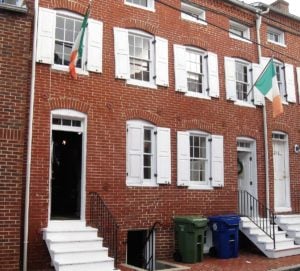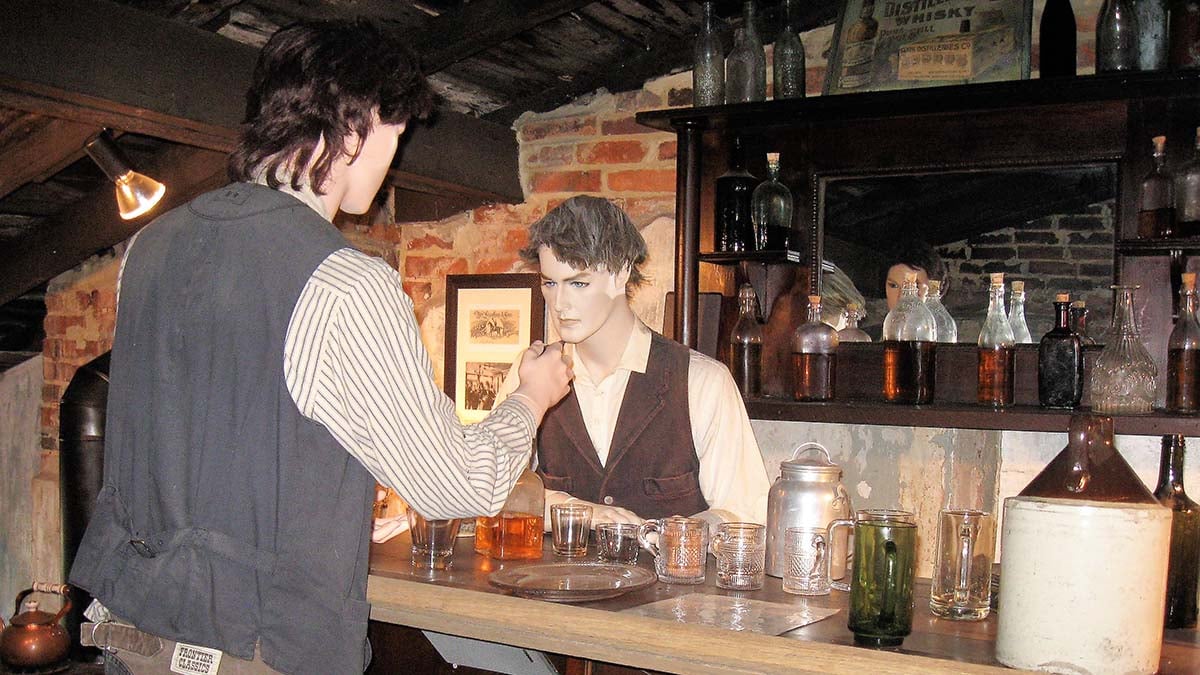Nestled in the shadow of the B&O Railroad’s iconic Roundhouse at Baltimore’s Mount Clare Station, not far from the harbor, is a row of brick townhomes that occupy the 900 block of Lemmon Street. History tells us that these houses were constructed during the summer of 1848 specifically for the ever-growing number of workers who came to Baltimore to work for the country’s first railroad, chartered in 1828. The houses, two-story-and-attic, were built by local carpenter Charles Shipley. All the homes in this block of Lemmon Street were purchased by Irish immigrants who came to West Baltimore during the 1840’s, escaping famine-riddled Ireland determined to begin new lives with the railroad in Baltimore.
Today, Lemmon Street rowhome numbers 918 and 920 serve the community as the Irish Railroad Workers Museum, a non-profit organization dedicated to the preservation of these historical alley houses and Baltimore’s Irish heritage, by maintaining an active presence in the community.
According to the US Census Bureau, 32.3 million Americans claim some portion of Irish heritage. That’s 10% of the population of this country and many of them are Seniors.
The Irish Railroad Workers Museum prides itself on its ability to help Irish descendants in Baltimore discover their roots. In the wake of Ireland’s Great Hunger, thousands of Irish escaped deaths by starvation, still risking life and limb, by sailing across the sea to America. The Irish settled in bustling port cities, particularly Brooklyn, Boston, and Baltimore, in search of better lives for themselves and their families. The museum staff was a group of citizens originally formed as the Railroad Historical District Corporation to stop the Lemmon Street rowhomes from demolition by the city.

The Lemmon Street alley homes sit in the center of a thriving community filled with an unmeasurable wealth of historical significance. The Baltimore & Ohio Railroad Museum, one block over, remains front and center as an integral part of the historic preservation of the area.
It’s a short walk from Lemmon Street to St. Peter the Apostle Catholic Church, in the heart of the 19th century Irish community. Built in 1843, the church played an important role as a social and moral hub in the community. St. Peter’s graveyard is probably the neighborhood’s best source of information for genealogy research as many former residents are buried there. Here’s a case in point, uncovered through the Museum staff’s research:
James and Sarah Feeley lived with their children in the house at 918 Lemmon Street in the 1860s and 1870s. Feeley worked for the railroad as a Boilermaker. He began his career in the 1860s as a laborer. By the 1870s he’d worked his way up to the boiler room in Mt. Clare Station. As a boilermaker, it was Feeley’s job to cut and shape the steel plates used to make boilers for the steam engines. Eventually, five of Feeley’s sons joined him at Mt. Clare Station. But in 1876 tragedy struck the family, not an uncommon occurrence in those days. James and Sarah’s youngest son, William, passed away from endocarditis (an infection of the heart) on March 6, at the tender age of 5 years and 7 months. Records show that young William was waked in his Lemmon Street home, the custom at that time. William was subsequently buried in St. Peter’s Cemetery on March 7, 1876, after a requiem Mass held at the church.
In keeping with the mission to preserve the Lemmon Street houses and promote their history, the Irish Railroad Workers Museum has returned 918 Lemmon Street to its likely appearance circa 1876. All three floors – two-story-and-attic – are period furnished, complete with costumed mannequins and many original artifacts lending detail to the scene. The two downstairs rooms – the reception room, and the kitchen- present an accurate picture of the Irish immigrant family’s simple but comfortable home. Upstairs, the period furnished bedrooms and attic show the typical resting places that accommodated large families.
The first floor in building next door at 920 Lemmon Street is equipped for special events and educational presentations by the Museum staff. It provides access to the back yards of both homes, where outdoor events are held, weather permitting. The second floor sets the scene for an essential part of neighborhood socializing and bonding – the corner bar. To say that in many Irish communities, a bar on every corner is not much of an exaggeration. The Lemmon Street “bar” and its “occupants” paint a picture of well-deserved leisure time after a long, hard day’s work. The attic contains displays depicting daily life and special occasions in old Baltimore.
The Irish Railroad Workers Museum sponsors and is involved with many Irish programs and events in and around Baltimore City. The Museum itself is open to the public by appointment (blame COVID-19) and groups tours by special arrangement. The Museum staff is friendly, knowledgeable, approachable, and eager to help. The IRWM participates in Baltimore City’s annual St. Patrick’s Day Parade as well as the Maryland Irish Festival held in Timonium. There is a newsletter you can sign up for to keep track of planned events as they happen.
The IRWM has joined with Irish Language Learners to sponsor Irish language classes. In 2013 there was an estimated 20,590 U.S. residents who spoke Irish Gaelic. That number is steadily increasing as more people on both sides of the pond join the cause to preserve the Irish language. The 2016 Irish Census put the population of Ireland at almost 5 million people. Of that number, less than 2 million speak Irish Gaelic and most of them live in the northwestern counties of Ireland where there are still pockets of spoken Irish.
Going forward, the future is looking bright for the Irish Railroad Workers Museum. The museum just purchased 4 more townhomes adjacent to the buildings currently in use on Lemmon Street. Future expansion and renovations will include restoration of the outside facades and the construction of additional historical displays depicting Irish life in 1840’s Baltimore. A visitors’ center is also planned. The purchase of the additional real estate was made possible by a board member who offered the directors a no-interest loan to fund the project.
Visit www.irishshrine.org, or email [email protected] or call 410-347-4747 to find out more.
Sharon is a freelance photojournalist and a proud “Bay” Boomer from Anne Arundel County. Contact Sharon via email at [email protected].

Let's keep in touch!
Keep up with the latest OutLook by the Bay information by signing up here. We promise not to waste your time.


